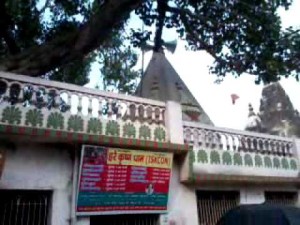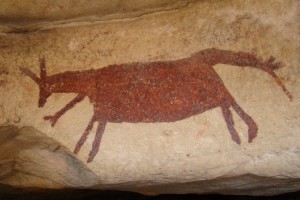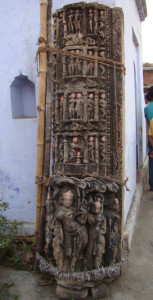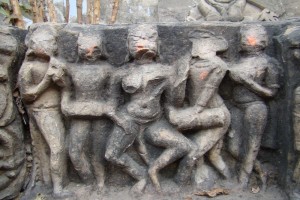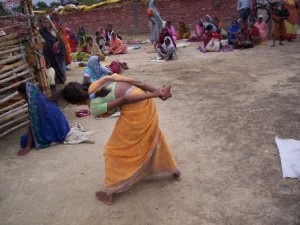-KAIMUR (BHABHUA) DISTRICT-
Kaimur was established in 1991. Divided into 2 sub-divisions viz., Bhabhua and Mohania, it mainly comprises of Plain and Plateau regions. total crop area of 291417. Known as the land of Kharwars and Ovaons, today it is inhabited by the Bhars, Cheros and Savars.While Rice, Wheat, Barley, Paddy and Pulses are considered to be the chief commercial crops of the district, Bamboo, Mango Orchards, Firewood, Tendu Leaf and Chiraunji are the prime forest products. With the possibility of a huge mineral reserve and other allied industries in the 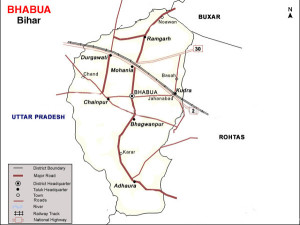 region, undoubtedly the district is all set to become an efficient socio-economic zone of Bihar.
region, undoubtedly the district is all set to become an efficient socio-economic zone of Bihar.
Latitude 240-54′ N
Longitude 830-40′ E
Total Area 3362 Square Kilometre
Maxm Temp (Summer)
Minm Temp (Winter)
Languages – Hindi, Bhojpuri,Urdu,English
Best Time to Visit – October to March
Height above Sea – Level – metre
River –
How To Reach
By Air(Airport) :-
189 km /Gaya International Airport and 211 km/ JayaPrakash Narayan International Airport,
By Rail :-
Kaimur has its nearest railway junction at Bhabua road(BBU).The railway route through Bhabua road is the Grand Chord line of Indian Railways in East Central Railway of Division Mughal Sarai, connecting Kolkata and New Delhi, and has three railway tracks running in parallel.
By Road :-
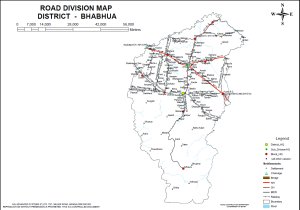 Apart from the NH- 2, 30 SH-14, 67 Other road-Bhabhua-Adhaura Rd, Bhabhua Sawar Road, Durgawati Hata Road, Kudra Parsathua Road, BhabHua-Chainpur Chand Rd, Kudra BhabHua Road, Ramgarh-Durgawati Rd, Hata – Mahdaich Road, Town Road
Apart from the NH- 2, 30 SH-14, 67 Other road-Bhabhua-Adhaura Rd, Bhabhua Sawar Road, Durgawati Hata Road, Kudra Parsathua Road, BhabHua-Chainpur Chand Rd, Kudra BhabHua Road, Ramgarh-Durgawati Rd, Hata – Mahdaich Road, Town Road
Popular tourist destinations
Kaimur Sanctuary :- Kaimur Wildlife Sanctuary is located at the borders of Bihar-Uttar Pradesh at Kaimur District. Area of the sanctuary is 1342 sq.km and was set up in 1982, which is mainly confined to hills and undulating ground.Along with Kaimur District, it spread over the wide range of Mirzapur District and Sonhadra Distict in UP. In the valley portions and at there are several waterfalls of which the finest are Karkat Waterfall and Telhar falls. There are several Lakes as well where as famous lake is Anupam Lake. Here is a type of pre historic Rock paintings found in the cave of this area are about 4000 year old and were discovered by Carlleyle in 1968. Most of the paintings are in terracotta colour and depict hunting, cattle grazing, war scenes, worshipping, bee-keeping, decorative floor designs, meeting, domestic chores. Near the Kaimur Wildlife world the tourists can find the Echo Valley. It is natural valley where phenomenon of echo is distinctly observed. Any sound thrown in the direction of the valley reflects its echo. The main animals found at Kaimur Wildlife Sanctuary are Black bucks,Blue bull, Nilgai, Chinkara, Tiger, Leopard, Hyena, Wild boar, sloth bear, karakal and bijju. It is home to more than 70 species of resident birds, which stay here all year around. A large number of migratory bird species also abounds at Kaimur Wildlife Sanctuary. The Sanctuary has a wide variety of wildlife in its lush green dense forest cover with numerous waterfalls, treasure of pre-historic caves, rock paintings & heritage of rare fossils. It is an ideal spot for winter tourism. Keeping in mind the prevailing weather conditions and the seasoning of migratory birds, the period from October and March is regarded as the ideal to visit.
Museum At Kaimur Hill:- It has one big hall and an additional smaller room. The big hall has a collection of various statues and rock 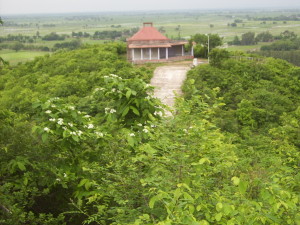
carvings mostly dating to the 6th and 7th centuries AD. It contains figures of religious significance drawn through the ages. The sculptures are well labeled but need more exhaustive descriptions regarding the significance of the exhibits. The smaller room has a large number of photographs of the rock paintings of the stone age period found in and around Karar village in the Kaimur Hills. Due to lack of spacesome rock sculptures are languishing in the open space encircling the museum.,
Kohira Dam:- Kohira reservoir project comprises of a dam on river Kohira to control catchment of about 87.80 sq km to utilize available water for irrigation through Kohira main canal system, off taking from a pickup weir (Rajapur) constructed about 4 km downstream 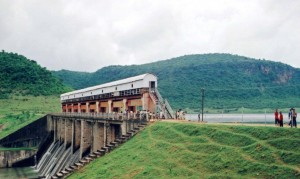 across the river Kohira. Subsequently, two high level canals, on either side of the dam were also added. Gross command area of Kohira main canal and left bank and right bank high level canals were 20243 hectare, 5830 hectare and 5668 hectare respectively. The project provides irrigation to Paddy during Kharif and wheat in rabi season in Chainpur and chand CD block of Rohtas district. the project was started in 1956 and completed during 1961-62. the dam is masonry cum earth and total lenght of the dam is 265.24 meter and maximum height is 12.80 meter. The spillway is having 10 number of radial gates of size 7.47×2.51 meter with capacity of spillway is 737 cumec. There are 4 number of irrigation sluices to release water for the weir.
across the river Kohira. Subsequently, two high level canals, on either side of the dam were also added. Gross command area of Kohira main canal and left bank and right bank high level canals were 20243 hectare, 5830 hectare and 5668 hectare respectively. The project provides irrigation to Paddy during Kharif and wheat in rabi season in Chainpur and chand CD block of Rohtas district. the project was started in 1956 and completed during 1961-62. the dam is masonry cum earth and total lenght of the dam is 265.24 meter and maximum height is 12.80 meter. The spillway is having 10 number of radial gates of size 7.47×2.51 meter with capacity of spillway is 737 cumec. There are 4 number of irrigation sluices to release water for the weir.
BHABHUA BLOCK
Bhabhua:- Exploration done by KP Jayaswal Research Institute marked site as Early Medieval period site. Ekauni Kot:-Exploration done by KP Jayaswal Research Institute marked site as Early Medieval period site. Khaira:-Exploration done by KP Jayaswal Research Institute marked site as Early Medieval period site.
Akhlaspur:- According to Jayaswal Research Institute Archaeological Explorations this site belongs to NBPW phase period.
Akhlaspur was also known as KHALASPUR. Baba Ji pokhara and sabari ka mandir temple is a very famous site . The village is situated at the middle of Surwara and Kuknahiya River.
Mokari :- Mokari have a famous of Shri Gosgir baba Temple near the Patahar.
Kamata :- Kamata village is situated 6 km north to the bhabua town. The village is the home of famous Patariha dih Baba brahma (In bhojpuri known as baram baba).Old Shiv Mandir, Purab Pokhra Mandir, Mahabir Mandir & Kali Mandir are famous temple of this village.
Kukurhi:- Exploration done by KP Jayaswal Research Institute marked site as Early Medieval period. Mahuat:- Exploration done by KP Jayaswal Research Institute marked site as Early Medieval period. Wadar Kot:- Exploration done by KP Jayaswal Research Institute marked site as NBPW phase. Chiraunapur:- Exploration done by KP Jayaswal Research Institute marked site as Early Medieval period. Belhari Kot:- Exploration done by KP Jayaswal Research Institute marked site as Early Medieval period. Ratwar Watch Tower:- Exploration done by KP Jayaswal Research Institute marked site as Early Medieval period. Kishanpura Road:- Exploration done by KP Jayaswal Research Institute marked site as Later Gupta Period. Bare mound:- Exploration done by KP Jayaswal Research Institute marked site as NBPW phase Period. Tarahani:- Exploration done by KP Jayaswal Research Institute marked site as Early Medieval period. Sonhan:- Exploration done by KP Jayaswal Research Institute marked site as Early Medieval period.
Akarta:-Exploration done by KP Jayaswal Research Institute marked site as Early Medieval period. Bhekas:- Exploration done by KP Jayaswal Research Institute marked site as Chalcolithic Period. Betri Kot:- Exploration done by KP Jayaswal Research Institute marked site as Early Medieval period. Darauli:- Exploration done by KP Jayaswal Research Institute marked site as Early Medieval period. Sion Kot:- Exploration done by KP Jayaswal Research Institute marked site as NBPW phase Period. Kunj Kot:- The KP Jayaswal Research Institute, during in the course of its Archaeological Explorations brought to light the site period NBPW phase Period Site. Koharan:- The KP Jayaswal Research Institute, during in the course of its Archaeological Explorations brought to light the site period Medieval Period Site. Jamuawan:- The KP Jayaswal Research Institute, during in the course of its Archaeological Explorations brought to light the site period NBPW phase Period Site. Kurasan:- The KP Jayaswal Research Institute, during in the course of its Archaeological Explorations brought to light the site period Early medieval Period Site. Ruppur:- The KP Jayaswal Research Institute, during in the course of its Archaeological Explorations brought to light the site period Early medieval Period Site.Sahpur:- The KP Jayaswal Research Institute, during in the course of its Archaeological Explorations brought to light the site period Early medieval Period Site. Dewarji Kalan:- The KP Jayaswal Research Institute, during in the course of its Archaeological Explorations brought to light the site period Early medieval Period Site. Mahadeva:- The KP Jayaswal Research Institute, during in the course of its Archaeological Explorations brought to light the site period Early medieval Period Site. Sikthi Khurd:- The KP Jayaswal Research Institute, during in the course of its Archaeological Explorations brought to light the site period NBPW phase Period Site.Piayan:- The KP Jayaswal Research Institute, during in the course of its Archaeological Explorations brought to light the site period Early medieval Period Site. Barka Kajhar:- The KP Jayaswal Research Institute, during in the course of its Archaeological Explorations brought to light the site period NBPW phase Period Site. Chamba Lal Ka Pokhar:- The KP Jayaswal Research Institute, during in the course of its Archaeological Explorations brought to light the site period Medieval Period Site. Raghubirpur:- The KP Jayaswal Research Institute, during in the course of its Archaeological Explorations brought to light the site period Late medieval Period Site. Kolhua Yard (Panditan Tola):- The KP Jayaswal Research Institute, during in the course of its Archaeological Explorations brought to light the site period Later Gupta Period Site.Shivpur:- The KP Jayaswal Research Institute, during in the course of its Archaeological Explorations brought to light the site period Early medieval Period Site.
Iskcon Temple:-
ADHAURA BLOCK
Telharkund Fall(Adhaura) :-
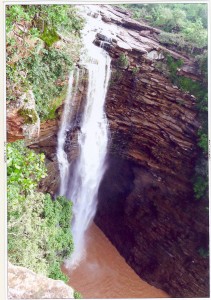
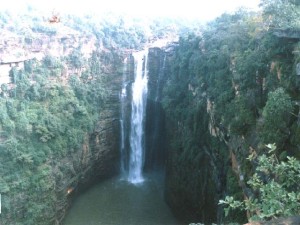 It is situated at a height of 2000 feet from the sea level on Kaimur plateau at a Distance of 58 Kms from Bhabua. Hills and surrounding forest make it an ideal tourist spot.Telharkund Falls (80m) on the Suara West River
It is situated at a height of 2000 feet from the sea level on Kaimur plateau at a Distance of 58 Kms from Bhabua. Hills and surrounding forest make it an ideal tourist spot.Telharkund Falls (80m) on the Suara West River
Rock shelters,painting mostly in red and rarely in white , depicting human and animals figures, hunting scenes, jungle scenes with Monkeys on trees were found during the exploration done by Archaeological Survey Of India in year 81-82.
Karkat Garh water fall:- It is situated Adhaura block near Kaimur Hill. It is famous for it crocodile sanctuary. Water showers from 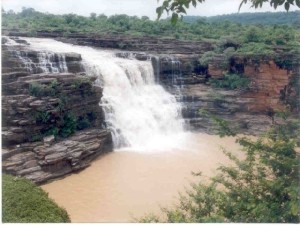 great height into very deep pool. Hence, it is believe that waterfall from great height causes the flow of undercurrent in the pool which prohibited the bathers and swimmer in the pool.
great height into very deep pool. Hence, it is believe that waterfall from great height causes the flow of undercurrent in the pool which prohibited the bathers and swimmer in the pool.
Koluha:-The KP Jayaswal Research Institute, during in the course of its Archaeological Explorations brought to light the site period Early medieval Period Site. Tumtum Manna (Barohia Hill):- The KP Jayaswal Research Institute, during in the course of its Archaeological Explorations brought to light the site period NBPW phase Period Site. Chaya:- The KP Jayaswal Research Institute, during in the course of its Archaeological Explorations brought to light the site period Mesolithic Period Site. Bazani Pahari:- The KP Jayaswal Research Institute, during in the course of its Archaeological Explorations brought to light the site period Mesolithic Period Site.
Jharpa:- In the course of Exploration done by ASI in year 81-82 , remains of stone temple with carved architectural members, carved panels and image were found at the place.
According to Jayaswal Research Institute Archaeological Explorations this site belongs to Early Medieval period. .
Dumrawan:- The KP Jayaswal Research Institute, during in the course of its Archaeological Explorations brought to light the site periodLate Mesolithic Period Site. Charain Manna (Sarodag):- The KP Jayaswal Research Institute, during in the course of its Archaeological Explorations brought to light the site period Late Neolithic Period Site. Jhariwa Dih:- The KP Jayaswal Research Institute, during in the course of its Archaeological Explorations brought to light the site period Mesolithic Period Site. Kokhargada:- The KP Jayaswal Research Institute, during in the course of its Archaeological Explorations brought to light the site period Mesolithic Period Site. Jhorgar (Nerus):- In the course of Exploration done by ASI in year 81-82 , remains of stone temple with carved architectural members were found at the place. As per exploration done by KP Jayswal Research Institute Early medieval marked site as Early Medieval period site. Tala:- The KP Jayaswal Research Institute, during in the course of its Archaeological Explorations brought to light the site period Early medieval Period Site. Chanma Manjari (Lohara):- The KP Jayaswal Research Institute, during in the course of its Archaeological Explorations brought to light the site period Late Mesolithic Period Site. Lohara Hill:- The KP Jayaswal Research Institute, during in the course of its Archaeological Explorations brought to light the site period Mesolithic Period Site.Bagha Duara Hill:- The KP Jayaswal Research Institute, during in the course of its Archaeological Explorations brought to light the site period Mesolithic Period Site.
Karar:- In the course of Exploration done by ASI in year 81-82 , stone sculpture panels depicting Ganesha and other female deities were noticed.
According to Jayaswal Research Institute Archaeological Explorations this site belongs to Early Medieval period.
Karamgarh:- The KP Jayaswal Research Institute, during in the course of its Archaeological Explorations brought to light the site period Early medieval Period Site.Baghdhari Hill (Chaya):- The KP Jayaswal Research Institute, during in the course of its Archaeological Explorations brought to light the site period Mesolithic Period Site. Jamuninar:- The KP Jayaswal Research Institute, during in the course of its Archaeological Explorations brought to light the site period Early medieval Period Site. Dabua:- The KP Jayaswal Research Institute, during in the course of its Archaeological Explorations brought to light the site period Mesolithic Period Site.Mamu Kabasa Hill (Lohara):- The KP Jayaswal Research Institute, during in the course of its Archaeological Explorations brought to light the site period Neolithic Period Site. Bahera:- The KP Jayaswal Research Institute, during in the course of its Archaeological Explorations brought to light the site period Late Neolithic Period Site. Sohniata:- The KP Jayaswal Research Institute, during in the course of its Archaeological Explorations brought to light the site period Mesolithic Period Site. Garale:- The KP Jayaswal Research Institute, during in the course of its Archaeological Explorations brought to light the site period Mesolithic Period Site. Okhargada:- The KP Jayaswal Research Institute, during in the course of its Archaeological Explorations brought to light the site period Mesolithic Period Site. Gamharia :- In the course of Exploration done by ASI in year 81-82 , architectural members and carved panels, one of them showing Ganesh and another a female figure were found at this place. Kanhanar:- In the course of Exploration done by ASI in year 81-82 , remains of stone temple with several carved architectural members carved panels depicting Ganesh and female figures and stone slab inscribed in early Devanagari Characters were found .
RAMGARH BLOCK
The Shiva Temple(Baidyanath) :-
It is situated in Baidyanath Village at 9 kms south of Ramgarh block headquarters. The temple is built by the rulers of Pratihara dynasty . Coins and valuables of historical importance have been unearthed here.According to archeologists, the temple was renovated in 812-13 AD.
Abhai Dih:-The KP Jayaswal Research Institute, during in the course of its Archaeological Explorations brought to light the site period NBPW Phase. Deohat (Sisauda):- The KP Jayaswal Research Institute, during in the course of its Archaeological Explorations brought to light the site period Later Gupta. Mukhrawan:- The KP Jayaswal Research Institute, during in the course of its Archaeological Explorations brought to light the site period Early medieval. Baghari Kot:-
The KP Jayaswal Research Institute, during in the course of its Archaeological Explorations brought to light the site period Chalcolithic.
Baijnath Kot:- The KP Jayaswal Research Institute, during in the course of its Archaeological Explorations brought to light the site period Chalcolithic.
BHAGWANPUR BLOCK
Bhagwanpur :- It is situated 11 Km south of Bhabua near the Kaimur hills. It is said to have been the seat of power of Kumar Chandrasen Saran Singh, who claimed his descent from Paras. It was confiscated by Sher Shah from Raja Shalivahan but later restored to his successor during the reign of Akbar.
Mundeshwari temple :–
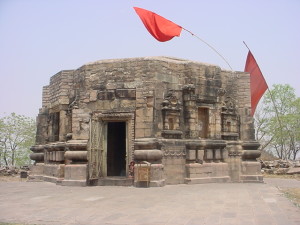 It is situated in Ramgarh village in the Bhagwanpur block in Bhabua Subdivision. It is built on a hilltop at a height of about 608 feet. Inscriptions of archeological importance found here describe the temple to be old enough to have been built around the year 635 A.D.The temple is in an octagonal shape. The sanctum sanctorum of the temple has an idol of Devi Mundeshwari. There is also a ‘Chaturmukha Shivling’ in the sanctum sanctorum. A clear indication that Shiva and Shakti were worshipped here.Also an indication that the temple might be part of the Tantric cult which is quite popular in the Eastern part of India.
It is situated in Ramgarh village in the Bhagwanpur block in Bhabua Subdivision. It is built on a hilltop at a height of about 608 feet. Inscriptions of archeological importance found here describe the temple to be old enough to have been built around the year 635 A.D.The temple is in an octagonal shape. The sanctum sanctorum of the temple has an idol of Devi Mundeshwari. There is also a ‘Chaturmukha Shivling’ in the sanctum sanctorum. A clear indication that Shiva and Shakti were worshipped here.Also an indication that the temple might be part of the Tantric cult which is quite popular in the Eastern part of India. 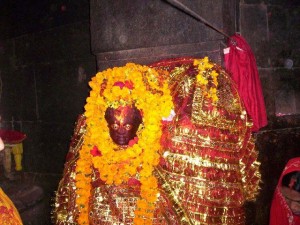 Experts believe that the temple was built during the Shaka Era.Interestingly, the present caretaker of the temple is Muslim, yet another example of the religious harmony at the grassroots level in India. The temple attracts devotees during festivals like Ramnavmi and Shivratri.
Experts believe that the temple was built during the Shaka Era.Interestingly, the present caretaker of the temple is Muslim, yet another example of the religious harmony at the grassroots level in India. The temple attracts devotees during festivals like Ramnavmi and Shivratri.
According to Jayaswal Research Institute Archaeological Explorations this site belongs to Gupta Period.
Masahi:-
Masahi village is situated at a distance of about 3e km from the block headquarter Bhagwanpur in Kaimur district. It is situated at a distance, of about 2 km from the very well known Masashi Mundeswari Temple . Masahi is a village by the side of the river Suvara where a mound, locally called as ‘Garh’. The mound or garh in Masashi village covering an area of about five acres is supposed to have had been the site of an ancient temple complex. Stone sculptures of standing and sitting Buddha and other Buddhist deities besides architectural remains like pillars, pilasters, beams, lintels, doorjambs, amalakas etc. have been found in large number from the site which suggests that during the Early Medieval period or even earlier there was a huge temple complex at this site. This can be as well ascertained by the fact that still large sized bricks are scattered on and around the mound and some brick structures are also remaining.
In the course of Exploration done by Department of Ancient Indian History, Culture and Archaeology, BHU in year 85-86, upper Palaeolithic tools, Sunga-Kushan pottery and animal figu-rine were found.
According to Jayaswal Research Institute Archaeological Explorations this site belongs to Early Medieval period..
Chorghatia :- The village is situated near Adhaura. It is an excellent beauty spot having water fall in the midst of a beautiful scenery.
Sunarigad:- The KP Jayaswal Research Institute, during in the course of its Archaeological Explorations brought to light the site period Early medieval Period Site.Bahuari Kot:- The KP Jayaswal Research Institute, during in the course of its Archaeological Explorations brought to light the site period Early medieval Period Site. Jaitpur Kalan:- The KP Jayaswal Research Institute, during in the course of its Archaeological Explorations brought to light the site period Kushan Period Site. Madhuri Siwan:- The KP Jayaswal Research Institute, during in the course of its Archaeological Explorations brought to light the site period NBPW phase Period Site.
Madhuri:- In the course of Exploration done by Department of Ancient Indian History, Culture and Archaeology, BHU in year 85-86, Early and late phase of N.B.P. black and red black slipped NBP greyna boels, sprinklers, iron slags , mullers, pestles, saddle-quern, lump of chalcedony with crested ridge and waste chips of chalcedony and chert were found.
According to Jayaswal Research Institute Archaeological Explorations this site belongs to NBPW Phase period .
Hanuman Ghat:- The KP Jayaswal Research Institute, during in the course of its Archaeological Explorations brought to light the site period NBPW phase Period Site. Silsila:- The KP Jayaswal Research Institute, during in the course of its Archaeological Explorations brought to light the site period NBPW phase Period Sit. Makari Khoh (Ropai Tola):- The KP Jayaswal Research Institute, during in the course of its Archaeological Explorations brought to light the site period Gupta Period Site. Malhua Pahar:- The KP Jayaswal Research Institute, during in the course of its Archaeological Explorations brought to light the site period Early medieval Period Site. Bhagwanpur:- The KP Jayaswal Research Institute, during in the course of its Archaeological Explorations brought to light the site period Early medieval Period Site. Kaser:- The KP Jayaswal Research Institute, during in the course of its Archaeological Explorations brought to light the site period Later Gupta Period Site. Gaura:- The KP Jayaswal Research Institute, during in the course of its Archaeological Explorations brought to light the site period Mauryan Period Site. Saraiya:- The KP Jayaswal Research Institute, during in the course of its Archaeological Explorations brought to light the site period Later Gupta Period Site. Umapur:- The KP Jayaswal Research Institute, during in the course of its Archaeological Explorations brought to light the site period Gupta Period Site. Paura Pahari (Ramgarh):- The KP Jayaswal Research Institute, during in the course of its Archaeological Explorations brought to light the site period Gupta Period Site. Rajbandha:- The KP Jayaswal Research Institute, during in the course of its Archaeological Explorations brought to light the site period Medieval Period Site. Matar:-The KP Jayaswal Research Institute, during in the course of its Archaeological Explorations brought to light the site period Later Gupta Period Site. Tola Dihan:- The KP Jayaswal Research Institute, during in the course of its Archaeological Explorations brought to light the site period Early medieval Period Site.
Tori:- In the course of Exploration done by Department of Ancient Indian History, Culture and Archaeology, BHU in year 85-86 ,Late phase NBP -black and red- red ware, coarse grey ware and red were found .
According to Jayaswal Research Institute Archaeological Explorations this site belongs to NBPW Phase period.
Parkot:- The KP Jayaswal Research Institute, during in the course of its Archaeological Explorations brought to light the site period Early medieval Period Site. Ghoraghatta:- The KP Jayaswal Research Institute, during in the course of its Archaeological Explorations brought to light the site period NBPW Phase Period Site. Deora Pahari (Kaser):- The KP Jayaswal Research Institute, during in the course of its Archaeological Explorations brought to light the site period Later Gupta Period Site. Khiri:- The KP Jayaswal Research Institute, during in the course of its Archaeological Explorations brought to light the site period NBPW phase Period Site. Parmalpur:- The KP Jayaswal Research Institute, during in the course of its Archaeological Explorations brought to light the site period Early medieval Period Site. Manikpur:- The KP Jayaswal Research Institute, during in the course of its Archaeological Explorations brought to light the site period Later Gupta Period Site. Mokaram:- The KP Jayaswal Research Institute, during in the course of its Archaeological Explorations brought to light the site period Early medieval Period Site. Nawghar:- The KP Jayaswal Research Institute, during in the course of its Archaeological Explorations brought to light the site period NBPW phase Period Site.
CHAINPUR BLOCK
Fort (Chainpur ):- It is situated 11 Km west of Bhabua headquarters. It contains a magnificent mausoleum of Bakhtiar Khan, whose son is said to have married the daughter of Sher Shah. The fort at Chainpur is a structure of Suri or Akbar period. Inside the rampart there is a Hindu shrine of “Harsu Brahm”.
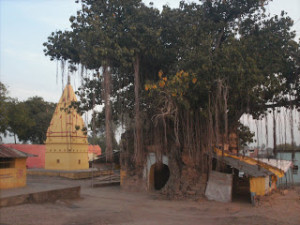
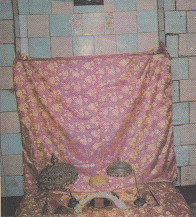 It is said that Harshu Pandey was a Kanyalkubya priest of Raja Shalivahan. He ended his life in protest against demolition of his house by sitting dharna at the door of the Raja in 1427 A.D, but during his cremation was seen standing at the cremation site at Varanasi. He became a Brahm and destroyed the Raja with his whole family except one daughter who was kind to him.
It is said that Harshu Pandey was a Kanyalkubya priest of Raja Shalivahan. He ended his life in protest against demolition of his house by sitting dharna at the door of the Raja in 1427 A.D, but during his cremation was seen standing at the cremation site at Varanasi. He became a Brahm and destroyed the Raja with his whole family except one daughter who was kind to him.
Tomb of Mohamad Bakhtiyar Khan ( Malik Sarai,Chainpur):-
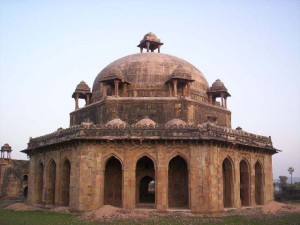 It is situated 11 Km west of Bhabua headquarters. It is credited with a great mausoleum of Bakhtiar Khan, who is said to have married the daughter of Sher Shah. This tomb was made by Bakhtiyar khan itself in 1568 for his last funeral after his death. The tomb is 88 x 70 sq meters in area.The outer radius of dome is 42 metres. There are 30 grave platforms in it.It has been declared national historical heritage.
It is situated 11 Km west of Bhabua headquarters. It is credited with a great mausoleum of Bakhtiar Khan, who is said to have married the daughter of Sher Shah. This tomb was made by Bakhtiyar khan itself in 1568 for his last funeral after his death. The tomb is 88 x 70 sq meters in area.The outer radius of dome is 42 metres. There are 30 grave platforms in it.It has been declared national historical heritage.
Madurni kot (Madurna):- The KP Jayaswal Research Institute, during in the course of its Archaeological Explorations brought to light the site period NBPW phase Period Site. Tiwai:- The KP Jayaswal Research Institute, during in the course of its Archaeological Explorations brought to light the site period Gupta Period Site. Siuar:- The KP Jayaswal Research Institute, during in the course of its Archaeological Explorations brought to light the site period Early medieval Period Site. Nawa Barat Siwan:- The KP Jayaswal Research Institute, during in the course of its Archaeological Explorations brought to light the site period Late Gupta Period Site. Amawan:- The KP Jayaswal Research Institute, during in the course of its Archaeological Explorations brought to light the site period Early medieval Period Site. Raghubirgarh:- The KP Jayaswal Research Institute, during in the course of its Archaeological Explorations brought to light the site period NBPW Phase Period Site. Dharahara:- The KP Jayaswal Research Institute, during in the course of its Archaeological Explorations brought to light the site period Early medieval Period Site. Kedli Dham:- The KP Jayaswal Research Institute, during in the course of its Archaeological Explorations brought to light the site period Gupta Period Site. Bardiha:- The KP Jayaswal Research Institute, during in the course of its Archaeological Explorations brought to light the site period NBPW phase Period Site. Bakhari Devi:- The KP Jayaswal Research Institute, during in the course of its Archaeological Explorations brought to light the site period Medieval Period Site. Jhapia Hill (Hamirpur):- The KP Jayaswal Research Institute, during in the course of its Archaeological Explorations brought to light the site period Mesolithic Period Site. Koindi:- The KP Jayaswal Research Institute, during in the course of its Archaeological Explorations brought to light the site period NBPW phase Period Site. Shangharbir Shaukhara Road:- The KP Jayaswal Research Institute, during in the course of its Archaeological Explorations brought to light the site period Early medieval Period Site. Madurna Hill:- The KP Jayaswal Research Institute, during in the course of its Archaeological Explorations brought to light the site period Early medieval Period Site. Prabhatpur Shangarbir:- The KP Jayaswal Research Institute, during in the course of its Archaeological Explorations brought to light the site period Medieval Period Site. Saraiyan:- The KP Jayaswal Research Institute, during in the course of its Archaeological Explorations brought to light the site period Early medieval Period Site. Diha:- The KP Jayaswal Research Institute, during in the course of its Archaeological Explorations brought to light the site period NBPW phase Period Site. Merh:- The KP Jayaswal Research Institute, during in the course of its Archaeological Explorations brought to light the site period Later Gupta Period Site. Tenaura:- The KP Jayaswal Research Institute, during in the course of its Archaeological Explorations brought to light the site period NBPW phase Period Site
NUAON BLOCK
Darauli :- Darauli village situated 8 Km North -East of Ramgarh contains two old temples built by the Cheros. Both the temples have been decorated with beautiful sculptures, carved on the spir.
According to Jayaswal Research Institute Archaeological Explorations this site belongs to Early medieval period.
Sadhu Ka Kot (Awanti):- The KP Jayaswal Research Institute, during in the course of its Archaeological Explorations brought to light the site period Early medieval Site. Chhata Baradih:- The KP Jayaswal Research Institute, during in the course of its Archaeological Explorations brought to light the site period Early medieval Site. Bari Kot (Bhopatpur):- The KP Jayaswal Research Institute, during in the course of its Archaeological Explorations brought to light the site period Early medieval site. Tulsipur kot:- The KP Jayaswal Research Institute, during in the course of its Archaeological Explorations brought to light the site period Early medieval Site.. Akholhi:- The KP Jayaswal Research Institute, during in the course of its Archaeological Explorations brought to light the site period Early medieval site. Baddha:- The KP Jayaswal Research Institute, during in the course of its Archaeological Explorations brought to light the site period Medieval site. Dumduma:- The KP Jayaswal Research Institute, during in the course of its Archaeological Explorations brought to light the site period Later Gupta site
KUDRA BLOCK
Kudra Dih:- The KP Jayaswal Research Institute, during in the course of its Archaeological Explorations brought to light the site period Early medieval site. Derwa:- The KP Jayaswal Research Institute, during in the course of its Archaeological Explorations brought to light the site period Early medieval Site. Purna Dih (Rampur):- The KP Jayaswal Research Institute, during in the course of its Archaeological Explorations brought to light the site period Early medieval Period Site. Piari Dih:-The KP Jayaswal Research Institute, during in the course of its Archaeological Explorations brought to light the site period Early medieval Period Site. Johari Dih:- The KP Jayaswal Research Institute, during in the course of its Archaeological Explorations brought to light the site period Medieval Period Site. Chatawnadih:- The KP Jayaswal Research Institute, during in the course of its Archaeological Explorations brought to light the site period NBPW phase Period Site. Larawan Dih:- The KP Jayaswal Research Institute, during in the course of its Archaeological Explorations brought to light the site period NBPW phase Period Site. Jagannath Temple (Jahanabad):- The KP Jayaswal Research Institute, during in the course of its Archaeological Explorations brought to light the site period Early medieval Period Site. Sasana Dih:- The KP Jayaswal Research Institute, during in the course of its Archaeological Explorations brought to light the site period Early medieval Period Site. Sakari:- The KP Jayaswal Research Institute, during in the course of its Archaeological Explorations brought to light the site period Early medieval Period Site. Chaturbhuj Dham (Raghunandanpur):- The KP Jayaswal Research Institute, during in the course of its Archaeological Explorations brought to light the site period Early medieval Period Site. Dumari Dih:- The KP Jayaswal Research Institute, during in the course of its Archaeological Explorations brought to light the site period Early medieval Period Site. Pachara:- The KP Jayaswal Research Institute, during in the course of its Archaeological Explorations brought to light the site period Chalcolithic Period Site. Baraka Nimdih:- The KP Jayaswal Research Institute, during in the course of its Archaeological Explorations brought to light the site period Early medieval period Site. Burhar (Murhar):- The KP Jayaswal Research Institute, during in the course of its Archaeological Explorations brought to light the site period Early medieval Period Site. Taruahan:- The KP Jayaswal Research Institute, during in the course of its Archaeological Explorations brought to light the site period Early medieval Period Site. Gora:- The KP Jayaswal Research Institute, during in the course of its Archaeological Explorations brought to light the site period Early medieval Period Site. Santanpur:- The KP Jayaswal Research Institute, during in the course of its Archaeological Explorations brought to light the site period Medieval Period site. Ghari:- The KP Jayaswal Research Institute, during in the course of its Archaeological Explorations brought to light the site period Mughal Period Site. Dain Dih:- The KP Jayaswal Research Institute, during in the course of its Archaeological Explorations brought to light the site period NBPW phase. site
RAMPUR BLOCK
Sawargad:- The KP Jayaswal Research Institute, during in the course of its Archaeological Explorations brought to light the site period NBPW phasePeriod site. Akodi:- The KP Jayaswal Research Institute, during in the course of its Archaeological Explorations brought to light the site period Early medieval Period Site. Chhotki Sawar:- The KP Jayaswal Research Institute, during in the course of its Archaeological Explorations brought to light the site period Early medieval Period Site. Raja Ka Akorhi Ka Kot:- The KP Jayaswal Research Institute, during in the course of its Archaeological Explorations brought to light the site period NBPW phasePeriod site. Sivpur:- The KP Jayaswal Research Institute, during in the course of its Archaeological Explorations brought to light the site period Early medieval Period Site. Nawadih:- The KP Jayaswal Research Institute, during in the course of its Archaeological Explorations brought to light the site period Early medieval Period Site. Barba Hill (Nauhatta):- The KP Jayaswal Research Institute, during in the course of its Archaeological Explorations brought to light the site period Gupta Period Site. Maraincha Garh:- The KP Jayaswal Research Institute, during in the course of its Archaeological Explorations brought to light the site period NBPW phasePeriod site. Belanw:- The KP Jayaswal Research Institute, during in the course of its Archaeological Explorations brought to light the site period Early medieval Period Site. Shivanar Garh:- The KP Jayaswal Research Institute, during in the course of its Archaeological Explorations brought to light the site period Early medieval Period Site. Persai:- The KP Jayaswal Research Institute, during in the course of its Archaeological Explorations brought to light the site period Early medieval Period Site.
CHAND BLOCK
Rajpura Hill:- The KP Jayaswal Research Institute, during in the course of its Archaeological Explorations brought to light the site period Mesolithic Period Site. Mokwa Hill (Dewane):- The KP Jayaswal Research Institute, during in the course of its Archaeological Explorations brought to light the site period Mesolithic Period Site. Pahraicha:- The KP Jayaswal Research Institute, during in the course of its Archaeological Explorations brought to light the site period Mesolithic Period Site. Patesar Hill:– The KP Jayaswal Research Institute, during in the course of its Archaeological Explorations brought to light the site period Kushan Period Site. Rampur Hill:- The KP Jayaswal Research Institute, during in the course of its Archaeological Explorations brought to light the site period Mesolithic Period Site. Gandh Kuti (Pitia Pahari):- The KP Jayaswal Research Institute, during in the course of its Archaeological Explorations brought to light the site period Mesolithic Period Site. Pitia Pahari:- The KP Jayaswal Research Institute, during in the course of its Archaeological Explorations brought to light the site period Mesolithic Period Site. Gajarba Hill:- The KP Jayaswal Research Institute, during in the course of its Archaeological Explorations brought to light the site period Late Mesolithic Period Site. Patna:- The KP Jayaswal Research Institute, during in the course of its Archaeological Explorations brought to light the site period NBPW phasePeriod site. Ratanpurwa Hill (Chhitampur):- The KP Jayaswal Research Institute, during in the course of its Archaeological Explorations brought to light the site period Mesolithic Period Site.
Minor Asokan Rock-Edict No.1:- This is one of the unique discoveries. The version of this Rock Edict is very akin to that of the Sasaram Minor Rock Edict 1. In the inscription, Asoka says that he had been an upasaka (lay worshipper) for more than two-and-a-half years and that in the beginning, he could not make significant progress. Only after his association with the sangha, he zealously propagated dhamma. Further, the emperor says that he made the people of Jambudvipa so virtuous that even gods came on earth and mingled with them. He informs that this proclamation was made by him when he was on tour for two hundred and fifty-six days. In the end, he exhorts that the inscription should be engraved on rocks and on pillars wherever available.
The KP Jayaswal Research Institute done the Archaeological Explorations of the following place, according the finding of Potsherds identify the site period as given in:-
Chhotki Bharari:- Early medieval Period Site. Bharari Khurd:- Early medieval Period Site. Dedua Bharari:– Early medieval Period Site. Mandranchal Hill:-Mesolithic Period Site. Bharkund Pahar (Basaha):- Mauryan Period Site. Nindaurgarh:- NBPW phase Period site..
MOHANIA BLOCK
The KP Jayaswal Research Institute done the Archaeological Explorations of the following place, according the finding of Potsherds identify the site period as given in:- Chhanwani (Sondhi):- Chalcolithic Period Site. Panapur:- Early medieval Period Site. Samhuta:– NBPW phase Period site. Dandwas:- NBPW phase Period site. Tirkolia (Bhokhari):- Early medieval Period Site. Gaura:- Early medieval Period Site. Bhagirathpur:- Early medieval Period Site. Semaria:- Early medieval Period Site.
Maricha:- It is Situated at 11 km from Bhabua. Here Surwara river & Kuknahia River meet. It id said that the name of Marichawn is given at the name of great saints Marich.
According to Jayaswal Research Institute Archaeological Explorations this site belongs to NBPW phasePeriod.
The KP Jayaswal Research Institute done the Archaeological Explorations of the following place, according the finding of Potsherds identify the site period as given in:-
Shankartola:- Early medieval Period Site. Mujan:- NBPW phasePeriod site. Surajpura:- Early medieval Period Site. Mohania:- Early medieval Period Site. Bharkhora:- Medieval Period Site. Patserwa kot:- Chalcolithic Period Site. Bhatawli Kot (Vatauli):- NBPW phasePeriod site. Bamhaur Khas:- Later Gupta Period Site. Gobindpur:- Early medieval Period Site. Lodia Dih (Dughara):– Early medieval Period Site. Akorhi:- Early medieval Period Site.
Siddhanath Temple(Ratan Puri Baba):-Situated near to village Bararura at the Bank of River Karmanasa. This is a famous Shiv temple established by Saint Ratanpuri Baba who was the disciples of great sage baba Gorakhnath.
DURGAWATI BLOCK
The KP Jayaswal Research Institute done the Archaeological Explorations of the following place, according the finding of Potsherds identify the site period as given in:- Kalyanpur:- Early medieval Period Site. Jaidpura:- Early medieval Period Site. Gajanpura:- Early medieval Period Site. Kalhanua:- Early medieval Period Site. Narsingha:- NBPW phasePeriod site. Sonawan (Gangapur):- NBPW phase Period site. Itahi:- Early medieval Period Site. Kotsa:- Early medieval Period Site. Kharsama:- Early medieval Period Site. Dhanaichha Dih:- Early medieval Period Site. Emirti Siwan:- Early medieval Period Site. Kulharia:- Early medieval Period Site. Karari:- Early medieval Period Site. Ruia (Ruhian):- Early medieval Period Site. Isari:- NBPW phase Period site. Bheria:– Early medieval Period Site. Karanpura:-Early medieval Period Site. Sawath:- Early medieval Period Site. Choruan Nuaon:- Early medieval Period Site.
REFERENCES:-
1.Indian Archaeology ……….. A Review
2.KP Jayaswal Research Institute-Archaeological Explorations
